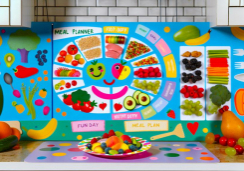What Secrets Tame Picky Eaters' Mealtime Battles?
Is there really a secret formula that can transform your dinnertime struggles with a picky eater into a peaceful experience? You've probably heard a variety of theories and tactics, but you may be wondering which ones hold water and can be seamlessly integrated into your family routine.
As you navigate the choppy waters of your child's selective eating habits, consider the notion that the answer may lie not in a single miraculous solution, but in a combination of strategies tailored to your unique situation.
From rethinking your approach to grocery shopping to implementing a no-pressure environment at the dinner table, there are tools that can tip the scales in favor of harmony and health.
Yet, the question remains: how can you apply these tactics effectively to see real change in your child's eating behavior? Stay tuned, as we're about to uncover the layers of this mealtime mystery, revealing insights that can potentially turn your next family dinner from a battleground into a celebration of tastes.
Embrace Structured Choices
Offering your child a selection of nutritious options empowers them to make positive food choices while giving you peace of mind that they're eating well. Picky eating can sometimes make family meals feel like a battleground, but structured choices are your secret weapon. By filling your pantry with healthy eats you'd love to see your kids enjoy, you set the stage for success without the fuss.
Here are some tips to help: let your children choose between two or three wholesome options for their meals and snacks. This way, they're involved in the decision-making, which can reduce mealtime struggles. For instance, ask if they'd prefer apple slices or carrot sticks with their lunch. The key is to offer selections that you're happy with, no matter what they pick.
Get kids excited about trying new foods by involving them in meal preparation. They're more likely to try something they've helped make. Whether it's sprinkling cheese on a homemade pizza or picking out which veggies go into a stir-fry, giving them a role can turn picky eaters into enthusiastic chefs.
Reinvent Familiar Favorites
By tweaking well-loved recipes with new ingredients, you can gently broaden your child's taste preferences without overwhelming them. This strategy of reinventing familiar favorites is a creative approach to introducing new tastes while reinforcing healthy eating habits. Let's make healthy eating fun by transforming a classic pizza with a rainbow of vegetable toppings or swapping out regular pasta for spiralized veggies in their beloved spaghetti dish.
As you reinvent these familiar favorites, remember that children know what they like, and drastic changes might ignite mealtime battles. Start by adding a sprinkle of new seasonings to their favorite soup, or mix a handful of diced veggies into their go-to omelet. This subtle shift encourages trying new foods in a comfortable context.
Additionally, you can make healthy versions of beloved meals by experimenting with cooking methods. Try baking instead of frying chicken tenders, or use herbs to flavor steamed veggies. These small tweaks maintain the essence of the dishes picky eaters love while gradually exposing them to healthier options.
Prioritize Family Mealtime
Establishing family mealtime as a cornerstone of daily life not only strengthens family bonds but also sets the stage for healthier eating habits for your children. When you prioritize sitting down together for dinner, your kids know it's an important part of the day. Here's how to make sure family mealtime every night is a success:
- Create a Routine: Set specific times for meals and stick to them, so children come to expect and prepare for the dinner table as part of their daily routine.
- Model Healthy Choices: Show by example. Eat healthy options and serve them at family meals, allowing your kids to see you enjoying a variety of foods.
- Involve Everyone: Let each member of the family be part of a meal, whether it's setting the table, choosing a side dish, or helping with the cooking.
- Keep it Positive: Ensure Mealtime is a stress-free time for sharing stories and enjoying each other's company, not a battleground over food choices.
Introduce Foods Gradually
While you're enjoying family meals and modeling healthy habits, remember to incorporate new foods slowly to help your child get used to a variety of tastes and textures. Introducing foods gradually is key to developing your child's palate and overcoming their picky eating tendencies. As your little one's taste buds are constantly evolving, exposing them to new flavors shouldn't be a rush job. It's like adding pieces to a puzzle; every new food is a piece that helps complete their picture of healthy eating habits.
Repeatedly offering new foods makes them less foreign and more comforting. It's not uncommon for children to initially reject certain foods, but don't be discouraged. Persistence can turn those nos into yesses. Serve up the same meals for everyone at the table, showing your child that they're part of the family food team. This way, they're learning that what's good for the whole family is good for them too.
Trying different preparations of the same food can also be a game-changer. Roasted, steamed, or blended into a soup—mixing it up can make all the difference in acceptance. So, when you're planning meals, think about gradual introductions and stay patient. Your child might just surprise you by being willing to eat something new!
Celebrate Small Victories
When your child takes a brave little nibble of broccoli or a courageous taste of quinoa, it's a milestone worth celebrating in the journey towards healthier eating habits. These small victories are the building blocks to ending the mealtime power struggles you're all too familiar with.
Here's some advice to help make meals a joyful experience:
- Praise the Effort: Acknowledge the bravery it takes to try new foods. 'Wow, you tried the broccoli, that's awesome!'
- Stay Positive: Even if they don't love it right away, focus on the positive. 'It's great that you gave it a go!'
- Make it Fun: Turn trying new foods into a game. 'For every new food you try, we'll do a happy dance!'
- Celebrate the Journey: Remember, it's not about a clean plate but the adventure of tasting the good stuff.
Each time they reach for at least one new food, you're guiding them towards a world of flavors. So, don't wait; celebrate small victories at every opportunity. This encouragement can transform reluctance into enthusiasm over time, making mealtime a fun exploration rather than a battleground.
Keep it up, and soon enough, the good stuff will be the go-to stuff!
Frequently Asked Questions
How Do You Tame a Picky Eater?
You'll conquer picky eating by encouraging taste exploration, using food games, and establishing a mealtime routine. Offer positive reinforcement, nutritional compromise, and creative presentation. Try peer modeling, flavor pairing, and sensory play, all with parental patience.
What Is the One Bite Rule for Picky Eaters?
The one-bite rule lets you explore new flavors with bite-sized rewards, making mealtime fun with creative plating and fun shapes. Consistency is key, and taste exposure through sensory play leads to loving more foods.
How Do You Beat a Picky Eater?
To beat a picky eater, try creative plating, flavor exploration, and mealtime games. Engage their senses, offer snacks as experiments, serve family-style, use positive reinforcement, leverage hunger, model eating with peers, and educate on nutrition.
What Are 3 Tips for Picky Eaters?
You'll win over picky eaters by using creative plating, engaging in food games, and encouraging taste exploration. Try sensory play, cutting food into fun shapes, and making colorful meals for successful veggie incorporation.
Conclusion
You've got this! Tackling your picky eater's habits can be smooth sailing with these tips.
Keep meals fun by mixing in new twists on their go-to foods.
Remember, family dinners are more than just eating—they're about bonding.
Introduce new foods bit by bit, and don't forget to cheer for every tiny win.
With patience and creativity, you'll nourish their bodies and encourage healthy eating.
Stay the course, and you'll see a world of difference at your dinner table.










